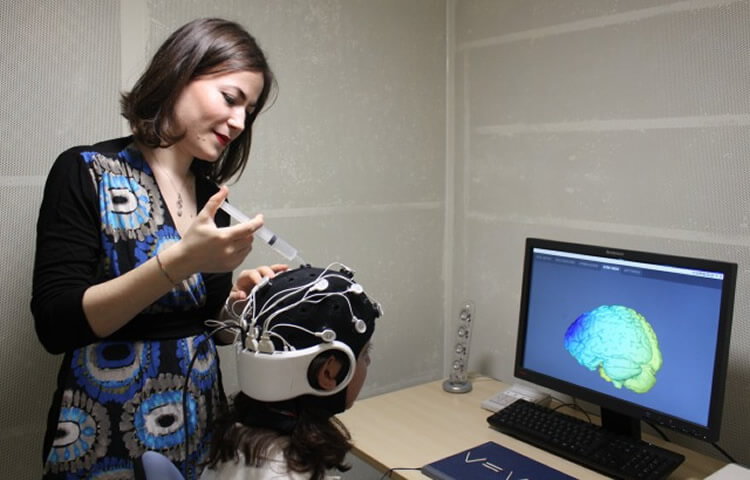
Researchers passed a weak constant electrical current through saline-soaked electrodes positioned over target regions in the scalp. NeuroscienceNews.com image is adapted from the QMUL news release.
Scientists have discovered how to boost creativity through brain stimulation, as mentioned by researchers at Queen Mary University of London (QMUL) and Goldsmiths University of London.
They managed this by briefly suppressing a key part of the frontal brain known as the left dorsolateral prefrontal cortex (DLPFC), that is participating in the majority of our thinking and reasoning.
The results, which were published in the journal Scientific Reports, prove that participants who took the intervention presented an improved competence to ‘think outside the box’ and be more creative.
“We solve problems by applying rules we learn from experience, and the DLPFC plays a key role in automating this process,” said Dr Caroline Di Bernardi Luft, first author from QMUL’s School of Biological and Chemical Sciences, who conducted the research while previously working at Goldsmiths University of London, with Dr Michael Banissy and Professor Joydeep Bhattacharya.
“It works fine most of the time, but fails spectacularly when we encounter new problems which require a new style of thinking – our past experience can indeed block our creativity. To break this mental fixation, we need to loosen up our learned rules,” she added.
The researchers used a technique known as transcranial direct current stimulation (tDCS), which included passing a weak constant electrical current through saline-soaked electrodes positioned over the scalp to modulate the excitability of the DLPFC. Based on the direction of the current flow, DLPFC was temporarily suppressed or activated. The very low currents applied ensured that it would not lead to any unpleasant sensation.
60 participants were tested on their creative problem-solving ability before and after receiving one of the following interventions: DLPFC being suppressed, DLPFC being activated, and DLPFC being unstimulated. The participants solved “matchstick problems”, some of which are difficult because to solve these problems, participants need to relax the already known rules of arithmetic and algebra.
The participants whose DLPFC was temporarily suppressed by the electrical stimulation were more likely to solve difficult problems than other participants whose DLPFC was activated or not stimulated. This shows that suppressing DLPFC briefly can contribute in breaking mental assumptions known from experience and thinking in more creative ways.
But the researchers also found that these participants were worse at solving problems with a higher working memory requirement (where they need to keep in mind many items at once). These problems demand that the participants try various moves until they find the solution, which means they have to remember all their mental operations.
“These results are important because they show the potential of improving mental functions relevant for creativity by non-invasive brain stimulation methods,” noted Dr. Luft.
“However, our results also suggest that potential applications of this technique will have to consider the target cognitive effects in more detail rather than just assuming tDCS can improve cognition as claimed by some companies which are starting to sell tDCS machines for home users,” she added.
“I would say that we are not yet in a position to wear an electrical hat and start stimulating our brain hoping for a blanket cognitive gain.”
Sources: Queen Mary University of London, Neurosciencenews.com












The superb work done by dr. wakina that brought back my husband encouraged me to wright this testimony, to motivate anybody out there fighting to sustain his or her relationship that there is still hope and ways to get back your lover because letting go will never heal a wounded heart, but finding the total cure does. I am happy woman today because of the right decisions and steps I took to fight for the man I wants to spend my entire life with and also the father of my child.
ReplyDeleteI had hope when I came across information and testimonies online by people writing on how their partner returned to them after a love spell from dr. wakina via his email dr.wakinalovetemple@gmail.com.
Before the love spell, I keep wondering how my husband moved from being a loving and caring father to a vile and nasty person overnight without reasons, unlike him. I searched myself to the ground and did not see the wrong I have done that made him pick up a bag of his cloths to his friends basement just five days to our eleventh anniversary without saying a word. I love him with every breath in me and I can do anything to make him love me gain. The testimonies and information I got about dr. wakina became my only hope after several failed attempt to get him back after he was gone for two weeks.
Freedom APK is what comes to mind when it comes to surfing and playing premium game without shelling out a dime for it.
ReplyDeleteMany users have complained that there are no free lunches in life but this app makes us believe otherwise. Want to know more about the Freedom app? Check out this Website